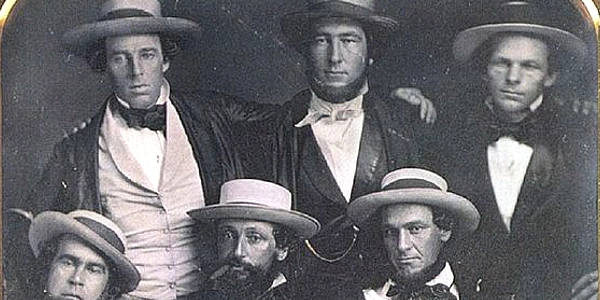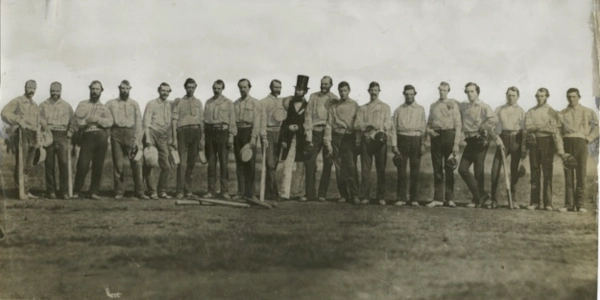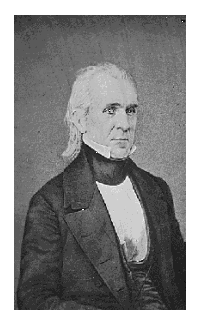Sponsor this page. Your banner or text ad can fill the space above.
Click here to Sponsor the page and how to reserve your ad.
-
Timeline
1849 - Detail
April 4, 1849 - The first baseball uniforms are introduced by the New York Knickerbockers club; blue and white cricket outfits were used.

The game of baseball was rounding into shape from its days of inception by founders across the nation, including Alexander Cartright, of the New York Knickerbockers, Abner Doubleday, and other pioneers who played the game by different names, town ball, rounders, and somewhat different rules. In 1845, the The New York Herald first mentioned the game in the newspapers. Rules were codified. Although there may have been players paid to play, there would be several more decades before the first professional league of any size and consequence, the National Association, began the first season, with the first game between the Fort Wayne Kekiongas and the Cleveland Forest Citys, April 4, 1871.
On that same date twenty-two years before, Alexander Cartwright's boys had worn the first uniforms in a game. The nine men wore blue and white. They were going to be hot with blue wool pants, but dapper in white shirts and a straw hat. Over the next fifty years, clubs began to adopt a uniform until by the turn of the century, all Major League Clubs had worn them. In fact, over four thousand different uniforms have been worn since 1876, the first year of the National League.
Those heavy wool flannel uniforms, or even those of wool and cotton, were the norm for the day through the 19th century. Their weight lessened by the 1940's by half, but it wouldn't be until after World War II that more comfortable fibers would clothe the players, ... thanks DuPont.
The tradition of home and away colors developed using white for home and gray or dark colors for the away team. In 1907, pin striping on away uniforms began, although some contend that pin striping had been a part of certain clubs as far back as the 1880's. By 1882, all clubs wore stockings, yes, from foot to knee. The collarless jersey began in 1906 with John McGraw's New York Giants. Through the 19th century, the nicknames of the teams never showed on their uniforms. It was not until 1905 when the Washington Senators decided to change their name to the Nationals that the name was spelled in bold capital letters on their home uniform fronts.
It was difficult to tell the players apart; numbers did not grace uniforms until 1916 when Cleveland placed digits on their sleeves. This tradition, however, faded away, until the New York Yankees, with their dominant teams, introduced bold big numbers of the backs of Ruth, Gehrig, and company in 1929. The numbers reflected their position in the normal batting order. By 1932, all teams had numbers on their backs. When did names appear? Not until 1960, revolutionized by the Chicago White Sox.

Other Uniform Tidbits
The Cincinnati Red Stockings in 1867 were the first club to wear knickers instead of pants. They were also, two years later, the first all-professional team. They barnstormed the country, playing anyone who wanted a game. The team went 57 wins and 0 losses.
In 1882, the leagues decided to wear multi-color uniforms corresponding to position, with only the stockings denoting the different teams. These were known, derisively, as clown costumes, and the teams stopped their use quickly, ... at mid-season.
First experiment with wearing numbered uniforms was concocted by the minor league Reading Red Roses, of the Atlantic League, in 1907. Their manager, Alfred Lawson, ordered the numbered uniforms, but there is no record whether they were ever worn in a game.
Knickerbocker History
Alexander Cartwright had been playing "town ball" for the Gotham Club of New York at Murray Hill in Manhattan, associated with Knickerbocker Engine Company 12. Several years later, he and several other members thought the club was growing too large, and decided to start an invitation only baseball team, the New York Knickerbockers. They rented Elysian Fields in Hoboken, New Jersey from steamboat entrepreneur Colonel John Stevens for $75 per year.
The team was started on September 23, 1845 with Duncan F. Curry as President. There would be twenty-eight original players in the social club, paying a $2 initiation fee and $5 yearly dues. Twenty rules were recorded for the game and player's conduct. The games within the club were to be divided into fair teams. You were not allowed to throw the ball at a player as an out. This differed from town ball or rounders. There would also be foul territory where the ball was out of play unlike previous games when there was none.
Although there had been games between themselves and perhaps other teams prior, the June 19, 1846 game between the Knickerbockers and what was now called the New York Nine (likely of the former Gothams) is often considered the first officially recorded game. It was played to their twenty rules with Alexander Cartwright as umpire, not player. The Knicks lost 23 to 1 over four innings. Once the National Association began purely professional play in 1871, the Knickerbockers club ceased play soon after.
Photo above: New York Knickerbockers Ball Club in 1847, Alexander Cartwright in the top center, William Wheaton, top left, 1847, Unknown. Courtesy Wikipedia Commons. Image Below: New York Knickerbockers baseball club in 1858, now in uniform, posing with their rivals, 1858, unknown author. Courtesy Library of Congress. Information Source: "Baseball Uniforms," Baseballalmanac.com, "Baseball Uniforms of the 20th Century," 1991, Marc Okkonen; "Dressed to the Nines," baseballhalloffame.org; "The Knickerbocker Baseball Club," 2002, Ralph Hickok; Wikipedia Commons.





